Marketing Intelligence Report
VerifiedAdded on 2020/02/05
|24
|6591
|190
Report
AI Summary
This marketing intelligence report analyzes Marks & Spencer (M&S) and British Airways. It examines the stages of the purchase decision-making process, theories of buyer behavior, and factors influencing buyer behavior, including the relationship between brand loyalty, corporate image, and repeat purchasing. The report details market research techniques, the achievement of marketing research objectives, and assessing the validity and reliability of findings. A marketing research plan is presented, along with a customer satisfaction survey and techniques for assessing customer response. Market size trends, competitor analysis for British Airways (using Porter's Five Forces), and an evaluation of opportunities and threats for British Airways are also included. The conclusion emphasizes the importance of considering all relevant parameters for successful organizational management and the need for effective decision-making based on customer needs and desires.
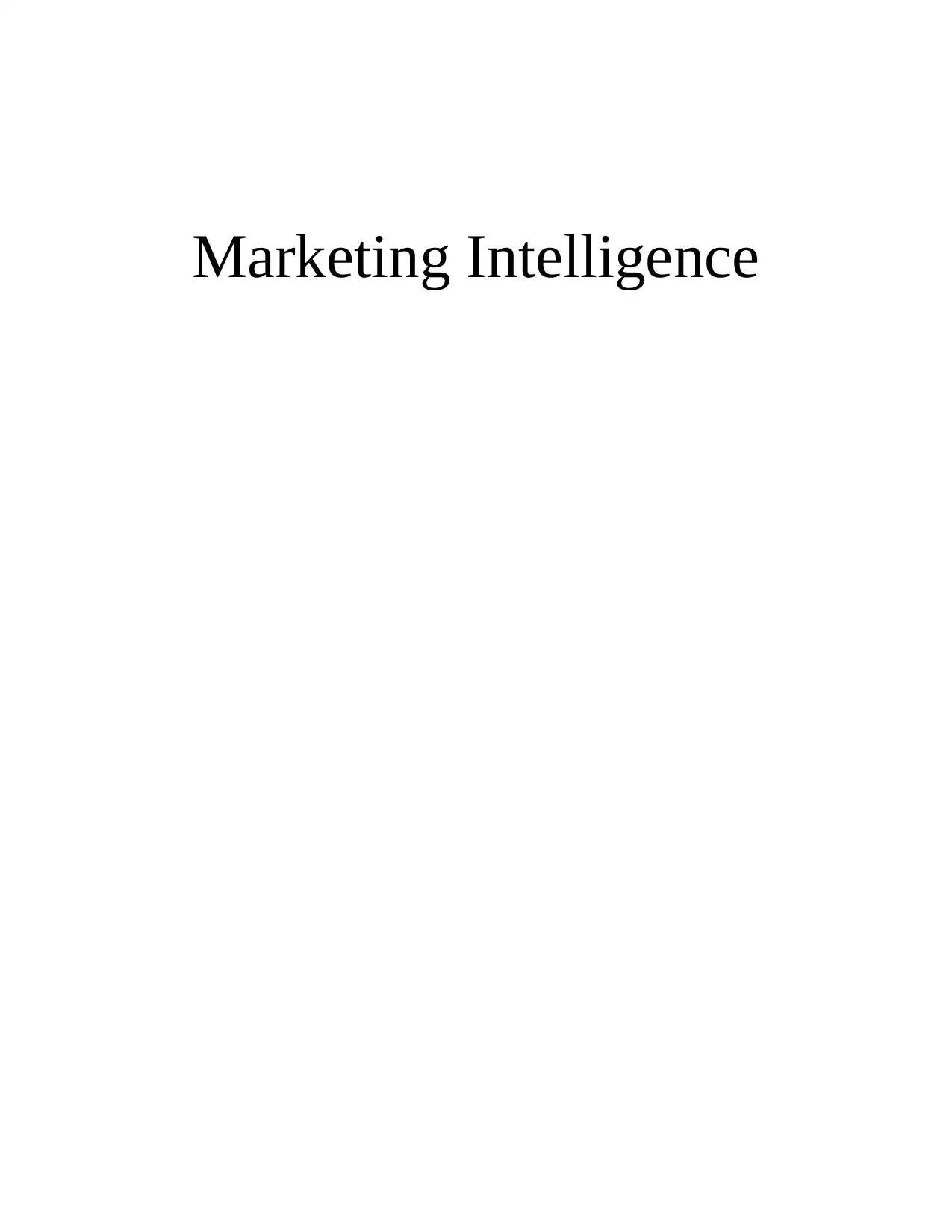
Marketing Intelligence
Paraphrase This Document
Need a fresh take? Get an instant paraphrase of this document with our AI Paraphraser
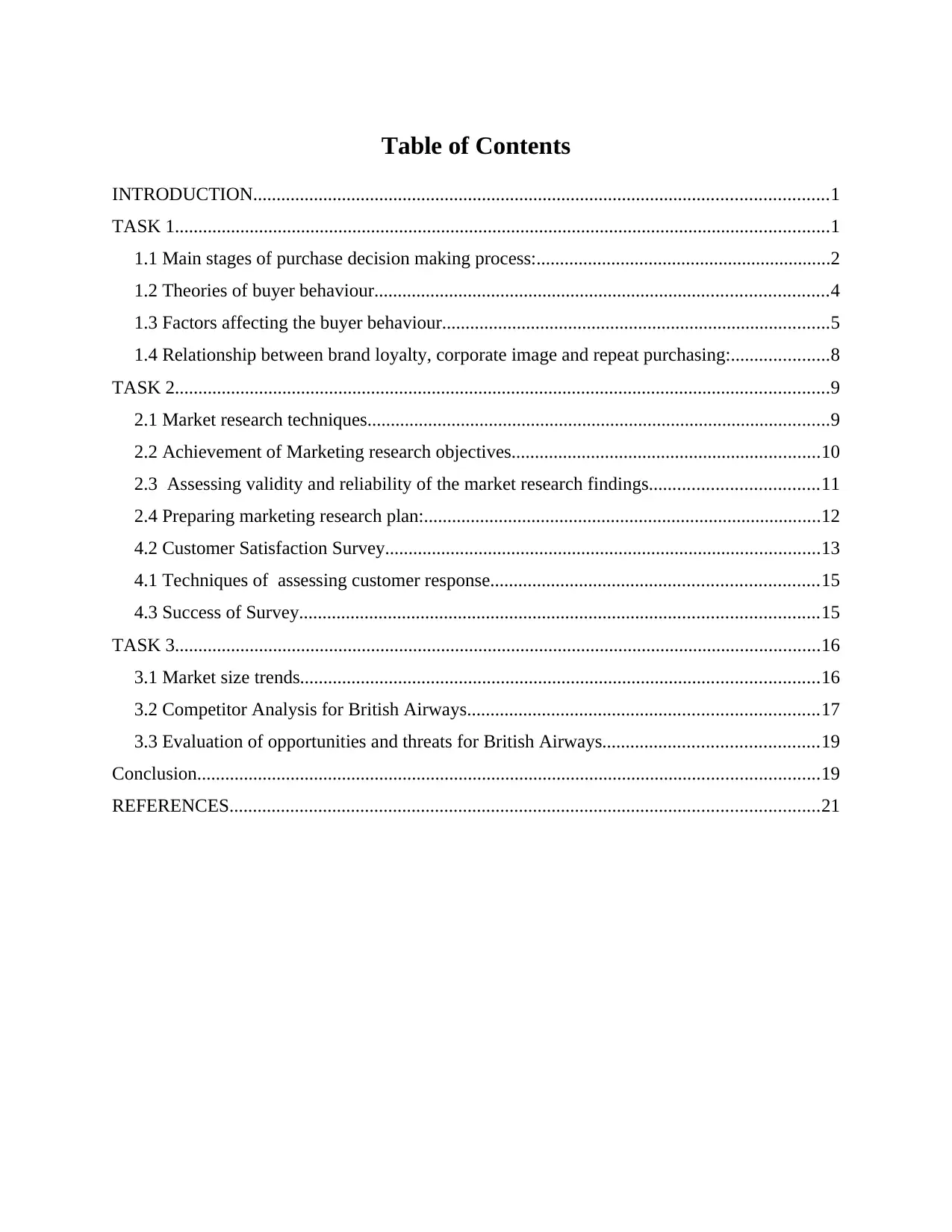
Table of Contents
INTRODUCTION...........................................................................................................................1
TASK 1............................................................................................................................................1
1.1 Main stages of purchase decision making process:...............................................................2
1.2 Theories of buyer behaviour.................................................................................................4
1.3 Factors affecting the buyer behaviour...................................................................................5
1.4 Relationship between brand loyalty, corporate image and repeat purchasing:.....................8
TASK 2............................................................................................................................................9
2.1 Market research techniques...................................................................................................9
2.2 Achievement of Marketing research objectives..................................................................10
2.3 Assessing validity and reliability of the market research findings....................................11
2.4 Preparing marketing research plan:.....................................................................................12
4.2 Customer Satisfaction Survey.............................................................................................13
4.1 Techniques of assessing customer response......................................................................15
4.3 Success of Survey...............................................................................................................15
TASK 3..........................................................................................................................................16
3.1 Market size trends...............................................................................................................16
3.2 Competitor Analysis for British Airways...........................................................................17
3.3 Evaluation of opportunities and threats for British Airways..............................................19
Conclusion.....................................................................................................................................19
REFERENCES..............................................................................................................................21
INTRODUCTION...........................................................................................................................1
TASK 1............................................................................................................................................1
1.1 Main stages of purchase decision making process:...............................................................2
1.2 Theories of buyer behaviour.................................................................................................4
1.3 Factors affecting the buyer behaviour...................................................................................5
1.4 Relationship between brand loyalty, corporate image and repeat purchasing:.....................8
TASK 2............................................................................................................................................9
2.1 Market research techniques...................................................................................................9
2.2 Achievement of Marketing research objectives..................................................................10
2.3 Assessing validity and reliability of the market research findings....................................11
2.4 Preparing marketing research plan:.....................................................................................12
4.2 Customer Satisfaction Survey.............................................................................................13
4.1 Techniques of assessing customer response......................................................................15
4.3 Success of Survey...............................................................................................................15
TASK 3..........................................................................................................................................16
3.1 Market size trends...............................................................................................................16
3.2 Competitor Analysis for British Airways...........................................................................17
3.3 Evaluation of opportunities and threats for British Airways..............................................19
Conclusion.....................................................................................................................................19
REFERENCES..............................................................................................................................21
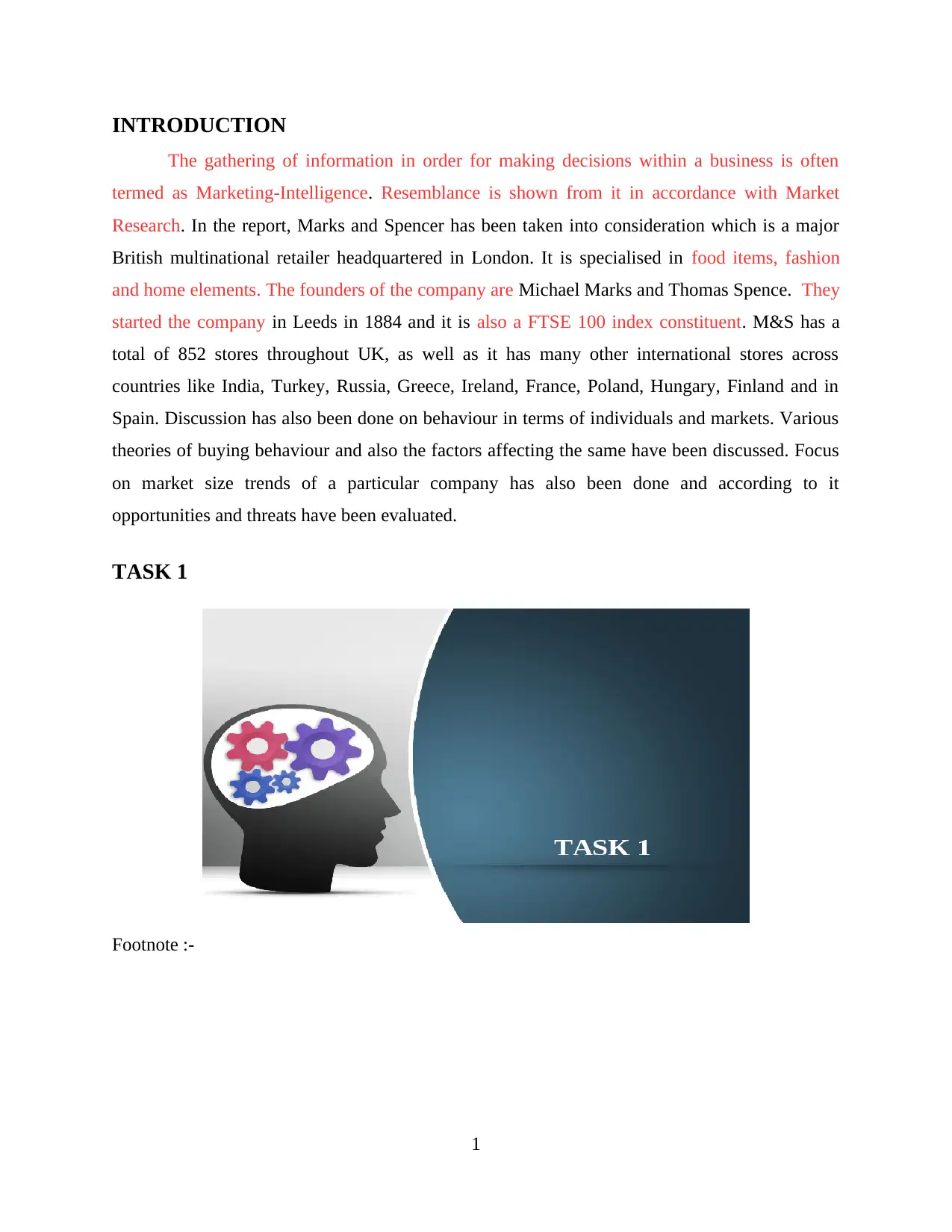
INTRODUCTION
The gathering of information in order for making decisions within a business is often
termed as Marketing-Intelligence. Resemblance is shown from it in accordance with Market
Research. In the report, Marks and Spencer has been taken into consideration which is a major
British multinational retailer headquartered in London. It is specialised in food items, fashion
and home elements. The founders of the company are Michael Marks and Thomas Spence. They
started the company in Leeds in 1884 and it is also a FTSE 100 index constituent. M&S has a
total of 852 stores throughout UK, as well as it has many other international stores across
countries like India, Turkey, Russia, Greece, Ireland, France, Poland, Hungary, Finland and in
Spain. Discussion has also been done on behaviour in terms of individuals and markets. Various
theories of buying behaviour and also the factors affecting the same have been discussed. Focus
on market size trends of a particular company has also been done and according to it
opportunities and threats have been evaluated.
TASK 1
Footnote :-
1
The gathering of information in order for making decisions within a business is often
termed as Marketing-Intelligence. Resemblance is shown from it in accordance with Market
Research. In the report, Marks and Spencer has been taken into consideration which is a major
British multinational retailer headquartered in London. It is specialised in food items, fashion
and home elements. The founders of the company are Michael Marks and Thomas Spence. They
started the company in Leeds in 1884 and it is also a FTSE 100 index constituent. M&S has a
total of 852 stores throughout UK, as well as it has many other international stores across
countries like India, Turkey, Russia, Greece, Ireland, France, Poland, Hungary, Finland and in
Spain. Discussion has also been done on behaviour in terms of individuals and markets. Various
theories of buying behaviour and also the factors affecting the same have been discussed. Focus
on market size trends of a particular company has also been done and according to it
opportunities and threats have been evaluated.
TASK 1
Footnote :-
1
⊘ This is a preview!⊘
Do you want full access?
Subscribe today to unlock all pages.

Trusted by 1+ million students worldwide
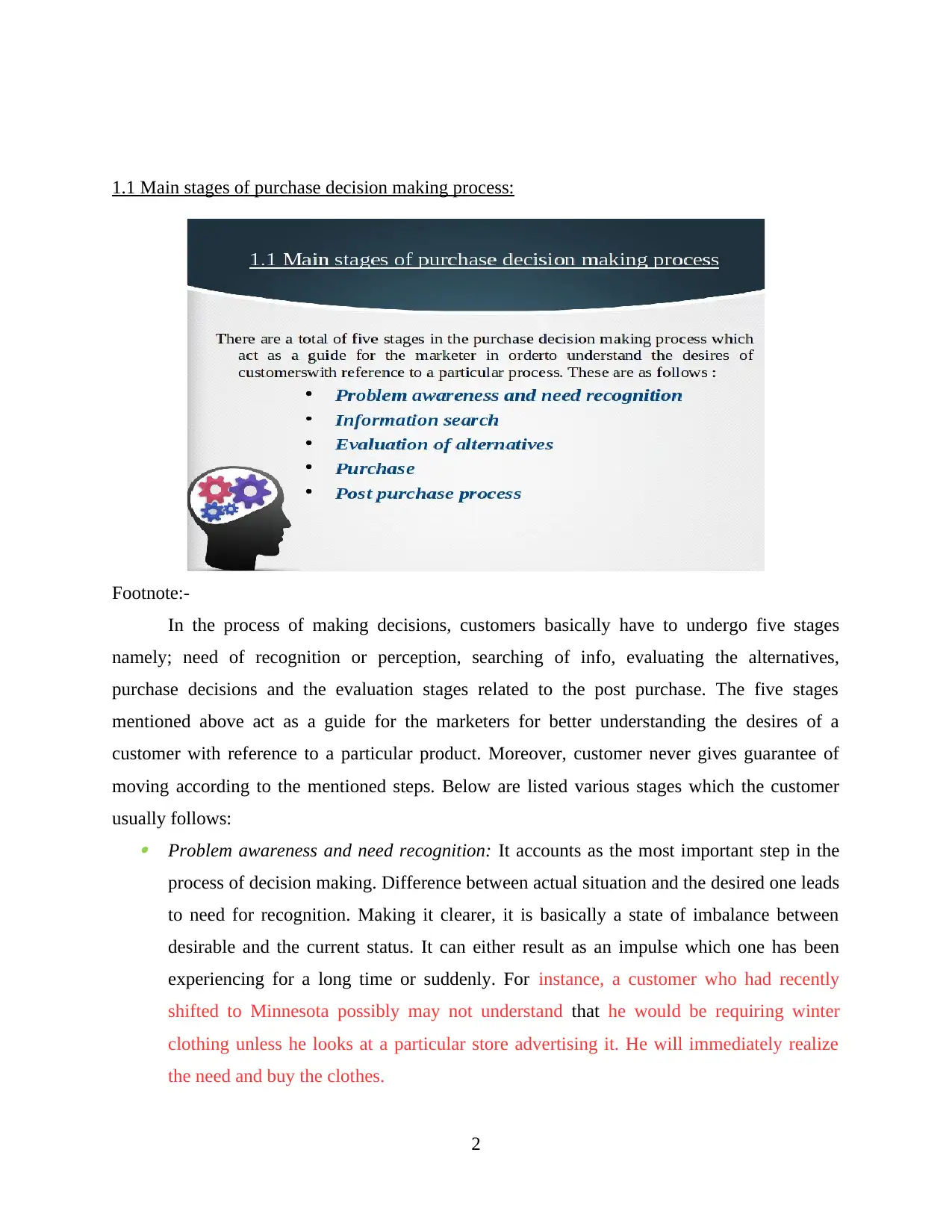
1.1 Main stages of purchase decision making process:
Footnote:-
In the process of making decisions, customers basically have to undergo five stages
namely; need of recognition or perception, searching of info, evaluating the alternatives,
purchase decisions and the evaluation stages related to the post purchase. The five stages
mentioned above act as a guide for the marketers for better understanding the desires of a
customer with reference to a particular product. Moreover, customer never gives guarantee of
moving according to the mentioned steps. Below are listed various stages which the customer
usually follows: Problem awareness and need recognition: It accounts as the most important step in the
process of decision making. Difference between actual situation and the desired one leads
to need for recognition. Making it clearer, it is basically a state of imbalance between
desirable and the current status. It can either result as an impulse which one has been
experiencing for a long time or suddenly. For instance, a customer who had recently
shifted to Minnesota possibly may not understand that he would be requiring winter
clothing unless he looks at a particular store advertising it. He will immediately realize
the need and buy the clothes.
2
Footnote:-
In the process of making decisions, customers basically have to undergo five stages
namely; need of recognition or perception, searching of info, evaluating the alternatives,
purchase decisions and the evaluation stages related to the post purchase. The five stages
mentioned above act as a guide for the marketers for better understanding the desires of a
customer with reference to a particular product. Moreover, customer never gives guarantee of
moving according to the mentioned steps. Below are listed various stages which the customer
usually follows: Problem awareness and need recognition: It accounts as the most important step in the
process of decision making. Difference between actual situation and the desired one leads
to need for recognition. Making it clearer, it is basically a state of imbalance between
desirable and the current status. It can either result as an impulse which one has been
experiencing for a long time or suddenly. For instance, a customer who had recently
shifted to Minnesota possibly may not understand that he would be requiring winter
clothing unless he looks at a particular store advertising it. He will immediately realize
the need and buy the clothes.
2
Paraphrase This Document
Need a fresh take? Get an instant paraphrase of this document with our AI Paraphraser
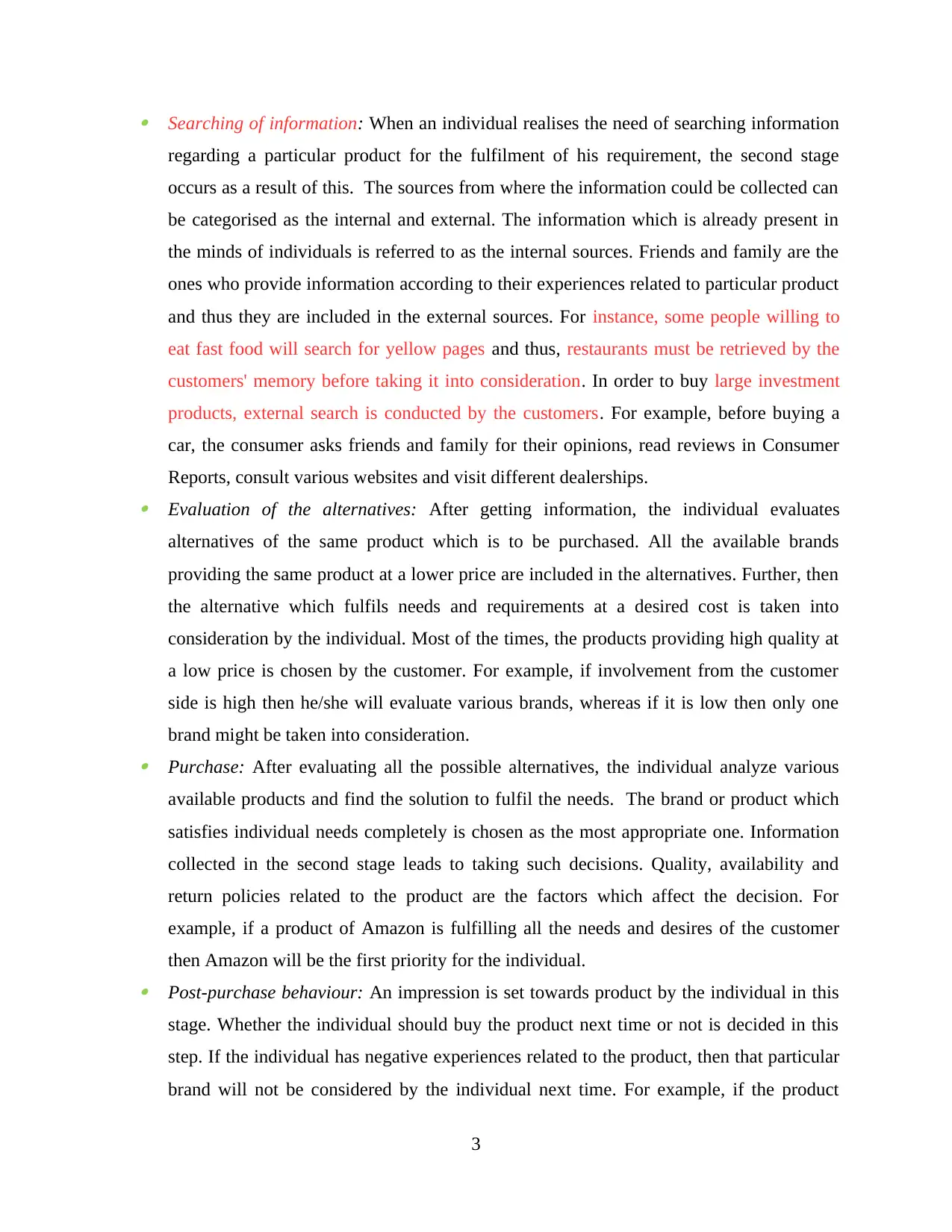
Searching of information: When an individual realises the need of searching information
regarding a particular product for the fulfilment of his requirement, the second stage
occurs as a result of this. The sources from where the information could be collected can
be categorised as the internal and external. The information which is already present in
the minds of individuals is referred to as the internal sources. Friends and family are the
ones who provide information according to their experiences related to particular product
and thus they are included in the external sources. For instance, some people willing to
eat fast food will search for yellow pages and thus, restaurants must be retrieved by the
customers' memory before taking it into consideration. In order to buy large investment
products, external search is conducted by the customers. For example, before buying a
car, the consumer asks friends and family for their opinions, read reviews in Consumer
Reports, consult various websites and visit different dealerships. Evaluation of the alternatives: After getting information, the individual evaluates
alternatives of the same product which is to be purchased. All the available brands
providing the same product at a lower price are included in the alternatives. Further, then
the alternative which fulfils needs and requirements at a desired cost is taken into
consideration by the individual. Most of the times, the products providing high quality at
a low price is chosen by the customer. For example, if involvement from the customer
side is high then he/she will evaluate various brands, whereas if it is low then only one
brand might be taken into consideration. Purchase: After evaluating all the possible alternatives, the individual analyze various
available products and find the solution to fulfil the needs. The brand or product which
satisfies individual needs completely is chosen as the most appropriate one. Information
collected in the second stage leads to taking such decisions. Quality, availability and
return policies related to the product are the factors which affect the decision. For
example, if a product of Amazon is fulfilling all the needs and desires of the customer
then Amazon will be the first priority for the individual. Post-purchase behaviour: An impression is set towards product by the individual in this
stage. Whether the individual should buy the product next time or not is decided in this
step. If the individual has negative experiences related to the product, then that particular
brand will not be considered by the individual next time. For example, if the product
3
regarding a particular product for the fulfilment of his requirement, the second stage
occurs as a result of this. The sources from where the information could be collected can
be categorised as the internal and external. The information which is already present in
the minds of individuals is referred to as the internal sources. Friends and family are the
ones who provide information according to their experiences related to particular product
and thus they are included in the external sources. For instance, some people willing to
eat fast food will search for yellow pages and thus, restaurants must be retrieved by the
customers' memory before taking it into consideration. In order to buy large investment
products, external search is conducted by the customers. For example, before buying a
car, the consumer asks friends and family for their opinions, read reviews in Consumer
Reports, consult various websites and visit different dealerships. Evaluation of the alternatives: After getting information, the individual evaluates
alternatives of the same product which is to be purchased. All the available brands
providing the same product at a lower price are included in the alternatives. Further, then
the alternative which fulfils needs and requirements at a desired cost is taken into
consideration by the individual. Most of the times, the products providing high quality at
a low price is chosen by the customer. For example, if involvement from the customer
side is high then he/she will evaluate various brands, whereas if it is low then only one
brand might be taken into consideration. Purchase: After evaluating all the possible alternatives, the individual analyze various
available products and find the solution to fulfil the needs. The brand or product which
satisfies individual needs completely is chosen as the most appropriate one. Information
collected in the second stage leads to taking such decisions. Quality, availability and
return policies related to the product are the factors which affect the decision. For
example, if a product of Amazon is fulfilling all the needs and desires of the customer
then Amazon will be the first priority for the individual. Post-purchase behaviour: An impression is set towards product by the individual in this
stage. Whether the individual should buy the product next time or not is decided in this
step. If the individual has negative experiences related to the product, then that particular
brand will not be considered by the individual next time. For example, if the product
3
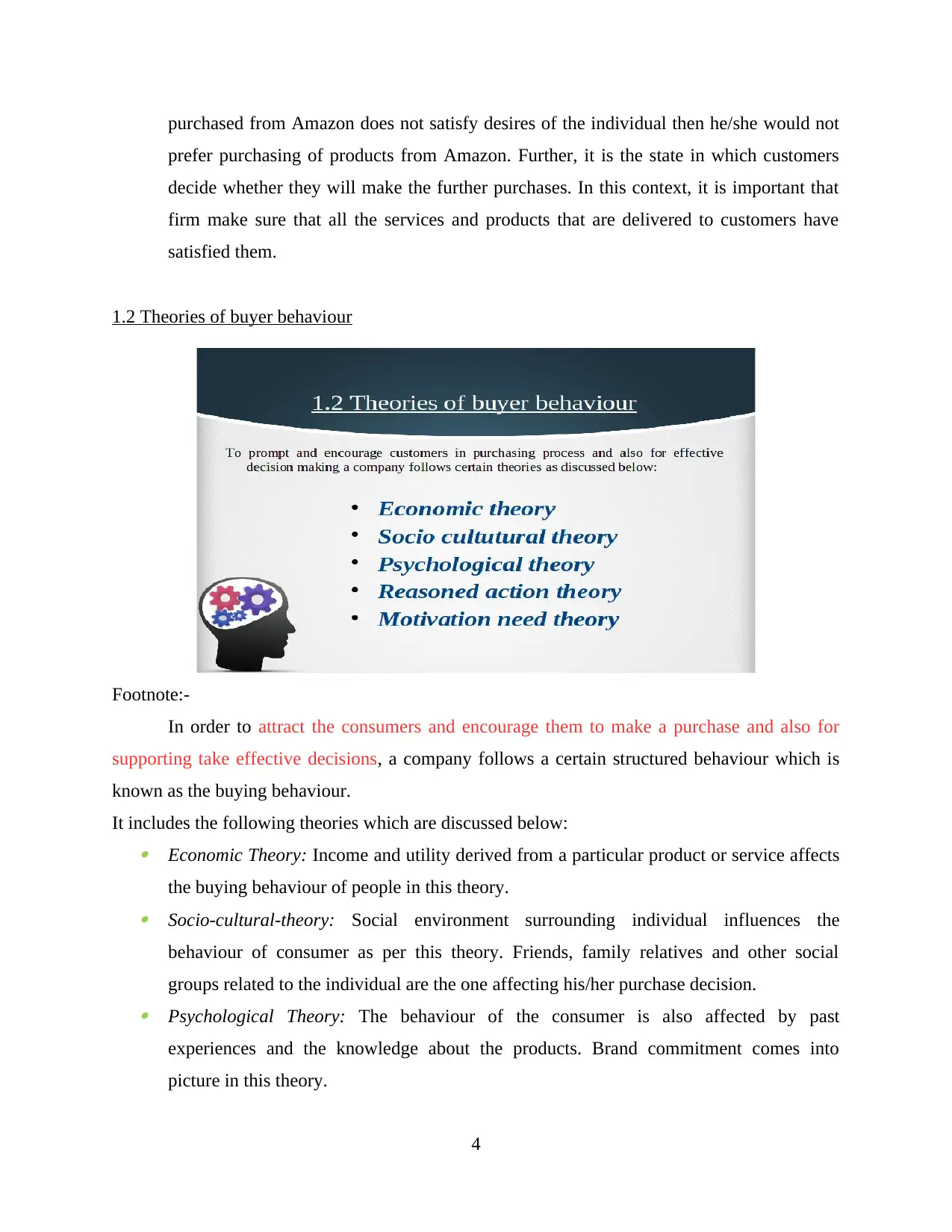
purchased from Amazon does not satisfy desires of the individual then he/she would not
prefer purchasing of products from Amazon. Further, it is the state in which customers
decide whether they will make the further purchases. In this context, it is important that
firm make sure that all the services and products that are delivered to customers have
satisfied them.
1.2 Theories of buyer behaviour
Footnote:-
In order to attract the consumers and encourage them to make a purchase and also for
supporting take effective decisions, a company follows a certain structured behaviour which is
known as the buying behaviour.
It includes the following theories which are discussed below: Economic Theory: Income and utility derived from a particular product or service affects
the buying behaviour of people in this theory. Socio-cultural-theory: Social environment surrounding individual influences the
behaviour of consumer as per this theory. Friends, family relatives and other social
groups related to the individual are the one affecting his/her purchase decision. Psychological Theory: The behaviour of the consumer is also affected by past
experiences and the knowledge about the products. Brand commitment comes into
picture in this theory.
4
prefer purchasing of products from Amazon. Further, it is the state in which customers
decide whether they will make the further purchases. In this context, it is important that
firm make sure that all the services and products that are delivered to customers have
satisfied them.
1.2 Theories of buyer behaviour
Footnote:-
In order to attract the consumers and encourage them to make a purchase and also for
supporting take effective decisions, a company follows a certain structured behaviour which is
known as the buying behaviour.
It includes the following theories which are discussed below: Economic Theory: Income and utility derived from a particular product or service affects
the buying behaviour of people in this theory. Socio-cultural-theory: Social environment surrounding individual influences the
behaviour of consumer as per this theory. Friends, family relatives and other social
groups related to the individual are the one affecting his/her purchase decision. Psychological Theory: The behaviour of the consumer is also affected by past
experiences and the knowledge about the products. Brand commitment comes into
picture in this theory.
4
⊘ This is a preview!⊘
Do you want full access?
Subscribe today to unlock all pages.

Trusted by 1+ million students worldwide
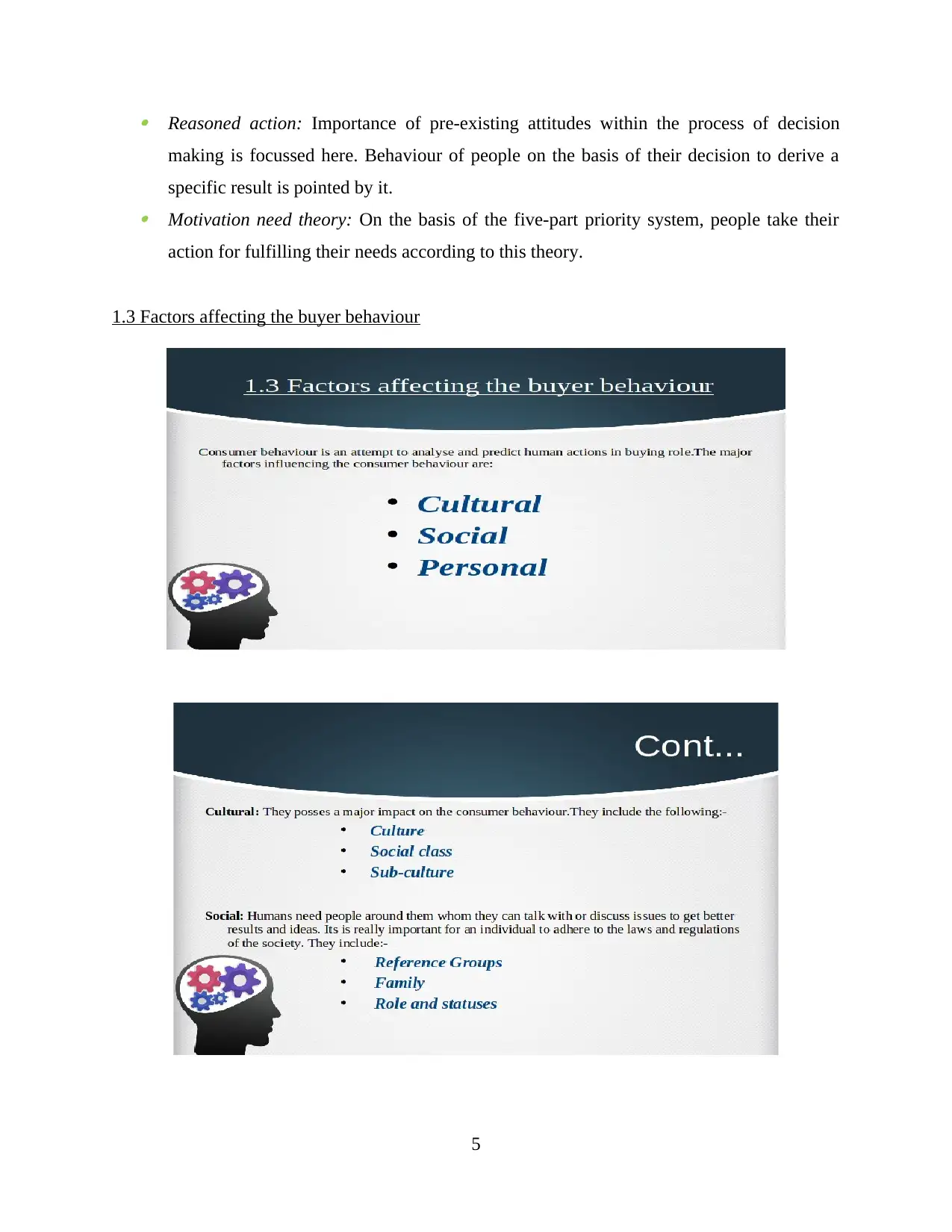
Reasoned action: Importance of pre-existing attitudes within the process of decision
making is focussed here. Behaviour of people on the basis of their decision to derive a
specific result is pointed by it. Motivation need theory: On the basis of the five-part priority system, people take their
action for fulfilling their needs according to this theory.
1.3 Factors affecting the buyer behaviour
5
making is focussed here. Behaviour of people on the basis of their decision to derive a
specific result is pointed by it. Motivation need theory: On the basis of the five-part priority system, people take their
action for fulfilling their needs according to this theory.
1.3 Factors affecting the buyer behaviour
5
Paraphrase This Document
Need a fresh take? Get an instant paraphrase of this document with our AI Paraphraser
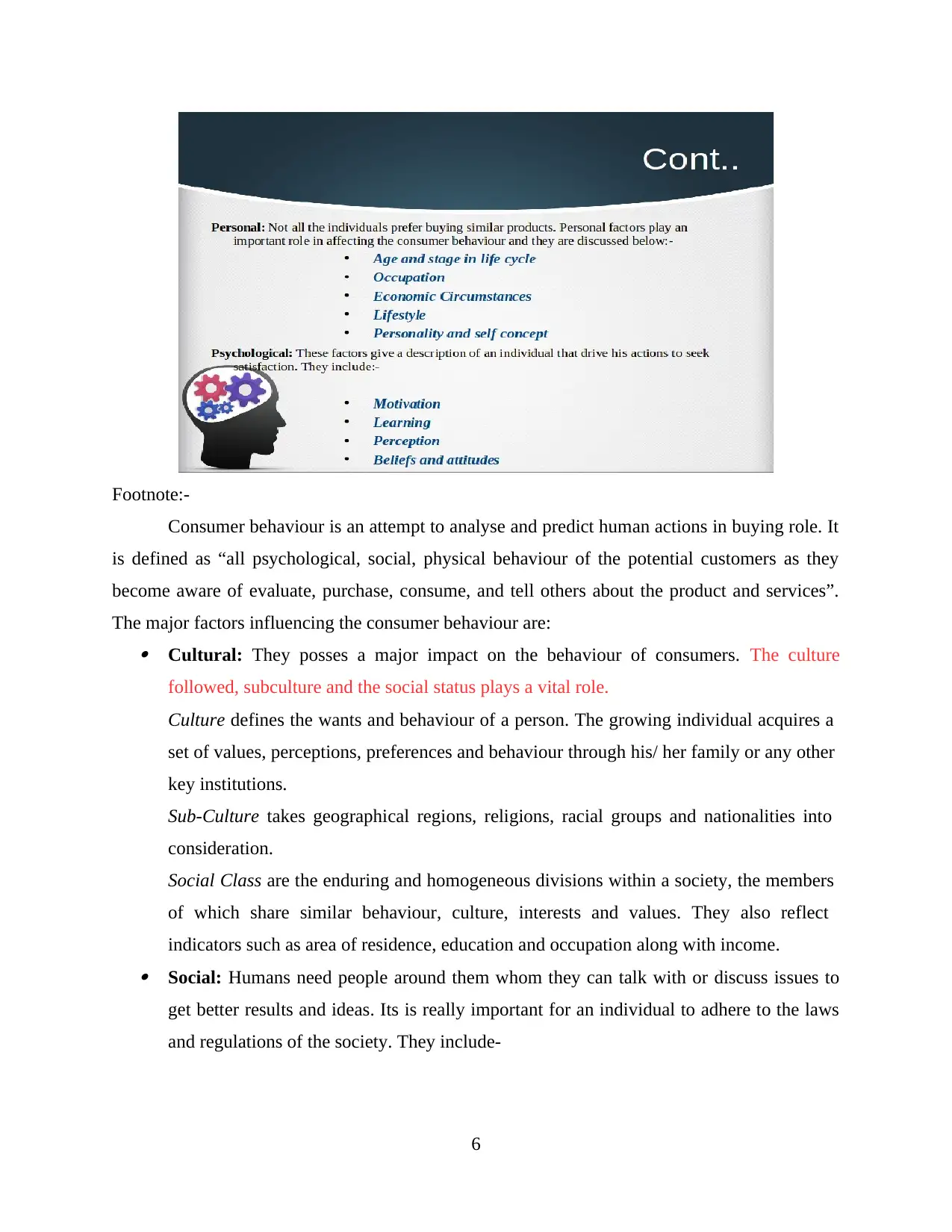
Footnote:-
Consumer behaviour is an attempt to analyse and predict human actions in buying role. It
is defined as “all psychological, social, physical behaviour of the potential customers as they
become aware of evaluate, purchase, consume, and tell others about the product and services”.
The major factors influencing the consumer behaviour are: Cultural: They posses a major impact on the behaviour of consumers. The culture
followed, subculture and the social status plays a vital role.
Culture defines the wants and behaviour of a person. The growing individual acquires a
set of values, perceptions, preferences and behaviour through his/ her family or any other
key institutions.
Sub-Culture takes geographical regions, religions, racial groups and nationalities into
consideration.
Social Class are the enduring and homogeneous divisions within a society, the members
of which share similar behaviour, culture, interests and values. They also reflect
indicators such as area of residence, education and occupation along with income. Social: Humans need people around them whom they can talk with or discuss issues to
get better results and ideas. Its is really important for an individual to adhere to the laws
and regulations of the society. They include-
6
Consumer behaviour is an attempt to analyse and predict human actions in buying role. It
is defined as “all psychological, social, physical behaviour of the potential customers as they
become aware of evaluate, purchase, consume, and tell others about the product and services”.
The major factors influencing the consumer behaviour are: Cultural: They posses a major impact on the behaviour of consumers. The culture
followed, subculture and the social status plays a vital role.
Culture defines the wants and behaviour of a person. The growing individual acquires a
set of values, perceptions, preferences and behaviour through his/ her family or any other
key institutions.
Sub-Culture takes geographical regions, religions, racial groups and nationalities into
consideration.
Social Class are the enduring and homogeneous divisions within a society, the members
of which share similar behaviour, culture, interests and values. They also reflect
indicators such as area of residence, education and occupation along with income. Social: Humans need people around them whom they can talk with or discuss issues to
get better results and ideas. Its is really important for an individual to adhere to the laws
and regulations of the society. They include-
6
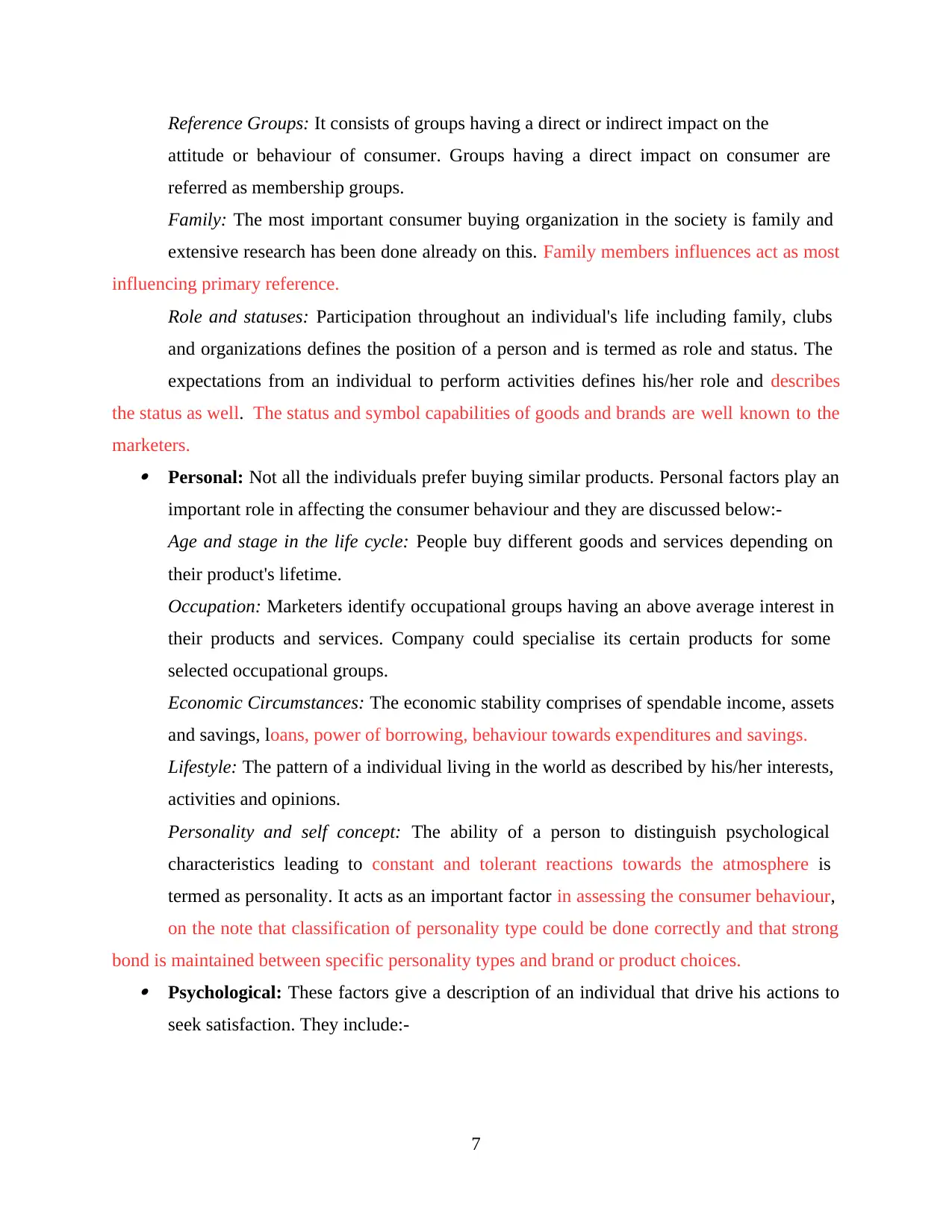
Reference Groups: It consists of groups having a direct or indirect impact on the
attitude or behaviour of consumer. Groups having a direct impact on consumer are
referred as membership groups.
Family: The most important consumer buying organization in the society is family and
extensive research has been done already on this. Family members influences act as most
influencing primary reference.
Role and statuses: Participation throughout an individual's life including family, clubs
and organizations defines the position of a person and is termed as role and status. The
expectations from an individual to perform activities defines his/her role and describes
the status as well. The status and symbol capabilities of goods and brands are well known to the
marketers. Personal: Not all the individuals prefer buying similar products. Personal factors play an
important role in affecting the consumer behaviour and they are discussed below:-
Age and stage in the life cycle: People buy different goods and services depending on
their product's lifetime.
Occupation: Marketers identify occupational groups having an above average interest in
their products and services. Company could specialise its certain products for some
selected occupational groups.
Economic Circumstances: The economic stability comprises of spendable income, assets
and savings, loans, power of borrowing, behaviour towards expenditures and savings.
Lifestyle: The pattern of a individual living in the world as described by his/her interests,
activities and opinions.
Personality and self concept: The ability of a person to distinguish psychological
characteristics leading to constant and tolerant reactions towards the atmosphere is
termed as personality. It acts as an important factor in assessing the consumer behaviour,
on the note that classification of personality type could be done correctly and that strong
bond is maintained between specific personality types and brand or product choices. Psychological: These factors give a description of an individual that drive his actions to
seek satisfaction. They include:-
7
attitude or behaviour of consumer. Groups having a direct impact on consumer are
referred as membership groups.
Family: The most important consumer buying organization in the society is family and
extensive research has been done already on this. Family members influences act as most
influencing primary reference.
Role and statuses: Participation throughout an individual's life including family, clubs
and organizations defines the position of a person and is termed as role and status. The
expectations from an individual to perform activities defines his/her role and describes
the status as well. The status and symbol capabilities of goods and brands are well known to the
marketers. Personal: Not all the individuals prefer buying similar products. Personal factors play an
important role in affecting the consumer behaviour and they are discussed below:-
Age and stage in the life cycle: People buy different goods and services depending on
their product's lifetime.
Occupation: Marketers identify occupational groups having an above average interest in
their products and services. Company could specialise its certain products for some
selected occupational groups.
Economic Circumstances: The economic stability comprises of spendable income, assets
and savings, loans, power of borrowing, behaviour towards expenditures and savings.
Lifestyle: The pattern of a individual living in the world as described by his/her interests,
activities and opinions.
Personality and self concept: The ability of a person to distinguish psychological
characteristics leading to constant and tolerant reactions towards the atmosphere is
termed as personality. It acts as an important factor in assessing the consumer behaviour,
on the note that classification of personality type could be done correctly and that strong
bond is maintained between specific personality types and brand or product choices. Psychological: These factors give a description of an individual that drive his actions to
seek satisfaction. They include:-
7
⊘ This is a preview!⊘
Do you want full access?
Subscribe today to unlock all pages.

Trusted by 1+ million students worldwide
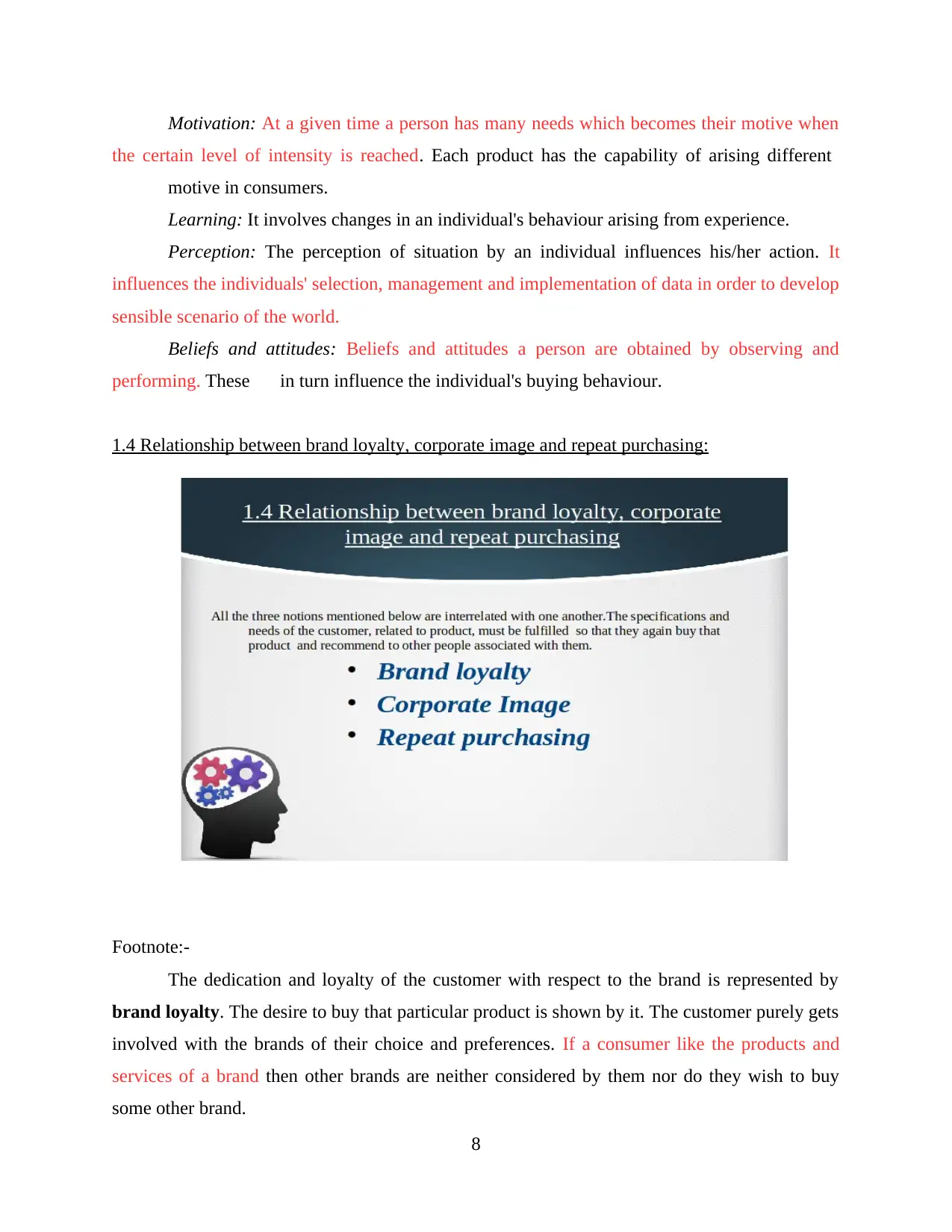
Motivation: At a given time a person has many needs which becomes their motive when
the certain level of intensity is reached. Each product has the capability of arising different
motive in consumers.
Learning: It involves changes in an individual's behaviour arising from experience.
Perception: The perception of situation by an individual influences his/her action. It
influences the individuals' selection, management and implementation of data in order to develop
sensible scenario of the world.
Beliefs and attitudes: Beliefs and attitudes a person are obtained by observing and
performing. These in turn influence the individual's buying behaviour.
1.4 Relationship between brand loyalty, corporate image and repeat purchasing:
Footnote:-
The dedication and loyalty of the customer with respect to the brand is represented by
brand loyalty. The desire to buy that particular product is shown by it. The customer purely gets
involved with the brands of their choice and preferences. If a consumer like the products and
services of a brand then other brands are neither considered by them nor do they wish to buy
some other brand.
8
the certain level of intensity is reached. Each product has the capability of arising different
motive in consumers.
Learning: It involves changes in an individual's behaviour arising from experience.
Perception: The perception of situation by an individual influences his/her action. It
influences the individuals' selection, management and implementation of data in order to develop
sensible scenario of the world.
Beliefs and attitudes: Beliefs and attitudes a person are obtained by observing and
performing. These in turn influence the individual's buying behaviour.
1.4 Relationship between brand loyalty, corporate image and repeat purchasing:
Footnote:-
The dedication and loyalty of the customer with respect to the brand is represented by
brand loyalty. The desire to buy that particular product is shown by it. The customer purely gets
involved with the brands of their choice and preferences. If a consumer like the products and
services of a brand then other brands are neither considered by them nor do they wish to buy
some other brand.
8
Paraphrase This Document
Need a fresh take? Get an instant paraphrase of this document with our AI Paraphraser
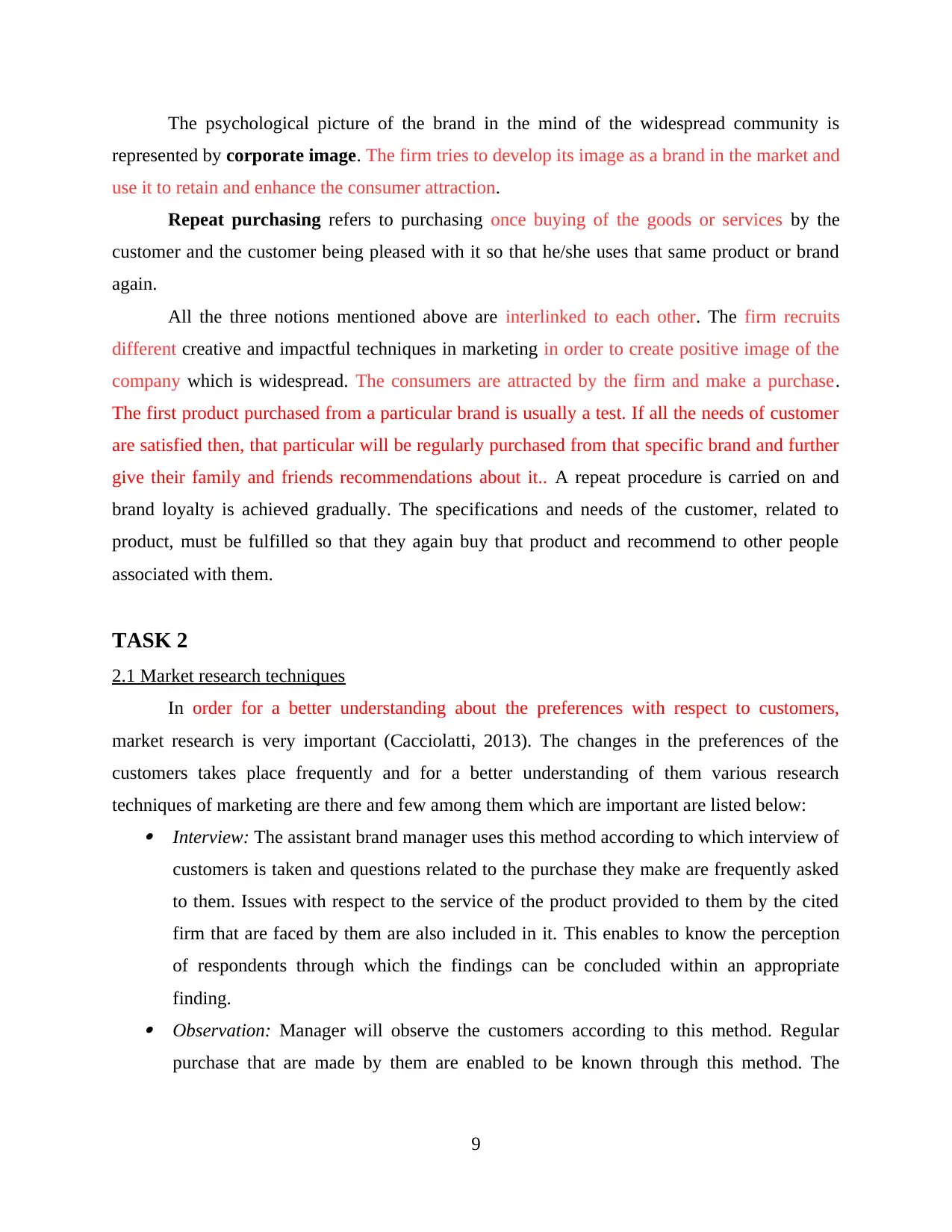
The psychological picture of the brand in the mind of the widespread community is
represented by corporate image. The firm tries to develop its image as a brand in the market and
use it to retain and enhance the consumer attraction.
Repeat purchasing refers to purchasing once buying of the goods or services by the
customer and the customer being pleased with it so that he/she uses that same product or brand
again.
All the three notions mentioned above are interlinked to each other. The firm recruits
different creative and impactful techniques in marketing in order to create positive image of the
company which is widespread. The consumers are attracted by the firm and make a purchase.
The first product purchased from a particular brand is usually a test. If all the needs of customer
are satisfied then, that particular will be regularly purchased from that specific brand and further
give their family and friends recommendations about it.. A repeat procedure is carried on and
brand loyalty is achieved gradually. The specifications and needs of the customer, related to
product, must be fulfilled so that they again buy that product and recommend to other people
associated with them.
TASK 2
2.1 Market research techniques
In order for a better understanding about the preferences with respect to customers,
market research is very important (Cacciolatti, 2013). The changes in the preferences of the
customers takes place frequently and for a better understanding of them various research
techniques of marketing are there and few among them which are important are listed below: Interview: The assistant brand manager uses this method according to which interview of
customers is taken and questions related to the purchase they make are frequently asked
to them. Issues with respect to the service of the product provided to them by the cited
firm that are faced by them are also included in it. This enables to know the perception
of respondents through which the findings can be concluded within an appropriate
finding. Observation: Manager will observe the customers according to this method. Regular
purchase that are made by them are enabled to be known through this method. The
9
represented by corporate image. The firm tries to develop its image as a brand in the market and
use it to retain and enhance the consumer attraction.
Repeat purchasing refers to purchasing once buying of the goods or services by the
customer and the customer being pleased with it so that he/she uses that same product or brand
again.
All the three notions mentioned above are interlinked to each other. The firm recruits
different creative and impactful techniques in marketing in order to create positive image of the
company which is widespread. The consumers are attracted by the firm and make a purchase.
The first product purchased from a particular brand is usually a test. If all the needs of customer
are satisfied then, that particular will be regularly purchased from that specific brand and further
give their family and friends recommendations about it.. A repeat procedure is carried on and
brand loyalty is achieved gradually. The specifications and needs of the customer, related to
product, must be fulfilled so that they again buy that product and recommend to other people
associated with them.
TASK 2
2.1 Market research techniques
In order for a better understanding about the preferences with respect to customers,
market research is very important (Cacciolatti, 2013). The changes in the preferences of the
customers takes place frequently and for a better understanding of them various research
techniques of marketing are there and few among them which are important are listed below: Interview: The assistant brand manager uses this method according to which interview of
customers is taken and questions related to the purchase they make are frequently asked
to them. Issues with respect to the service of the product provided to them by the cited
firm that are faced by them are also included in it. This enables to know the perception
of respondents through which the findings can be concluded within an appropriate
finding. Observation: Manager will observe the customers according to this method. Regular
purchase that are made by them are enabled to be known through this method. The
9
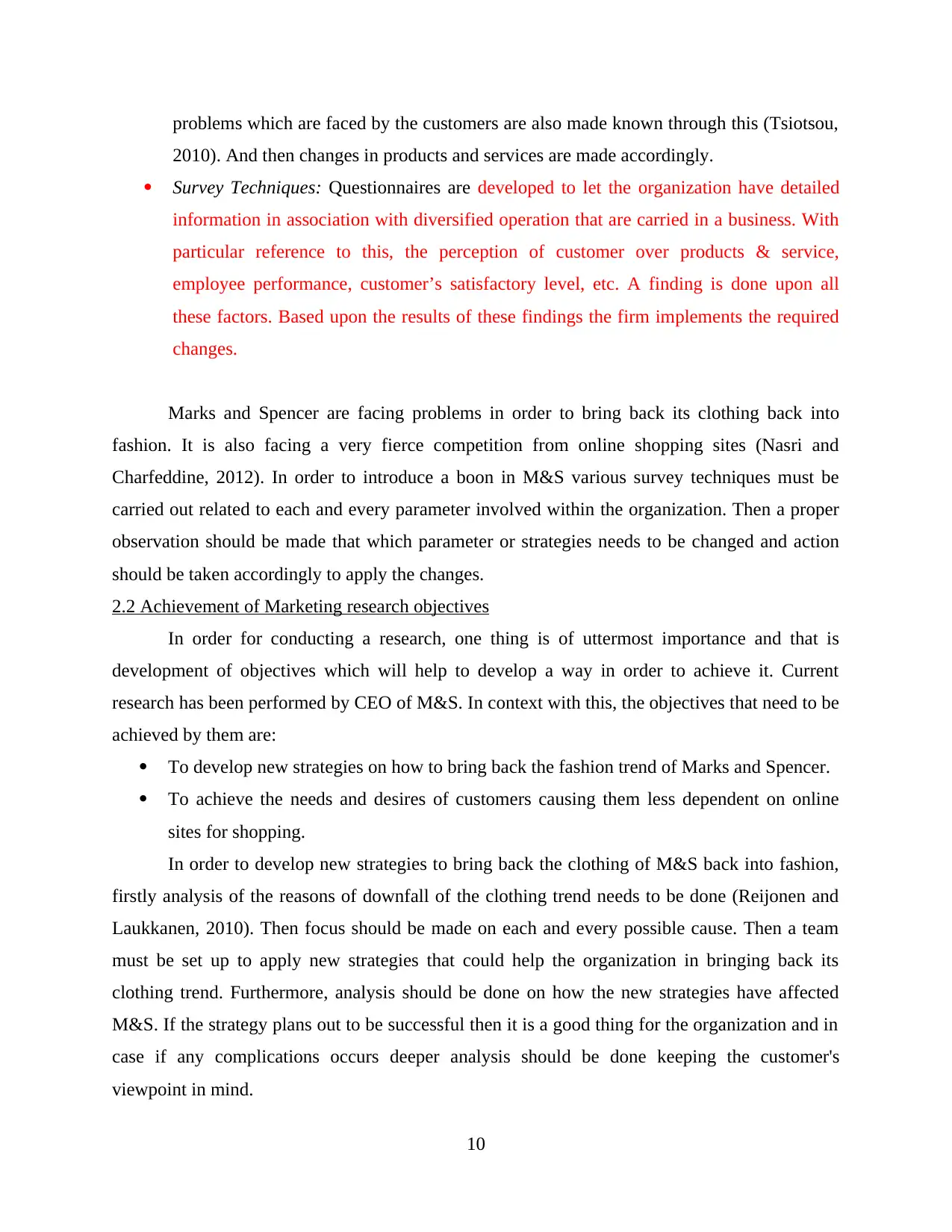
problems which are faced by the customers are also made known through this (Tsiotsou,
2010). And then changes in products and services are made accordingly.
Survey Techniques: Questionnaires are developed to let the organization have detailed
information in association with diversified operation that are carried in a business. With
particular reference to this, the perception of customer over products & service,
employee performance, customer’s satisfactory level, etc. A finding is done upon all
these factors. Based upon the results of these findings the firm implements the required
changes.
Marks and Spencer are facing problems in order to bring back its clothing back into
fashion. It is also facing a very fierce competition from online shopping sites (Nasri and
Charfeddine, 2012). In order to introduce a boon in M&S various survey techniques must be
carried out related to each and every parameter involved within the organization. Then a proper
observation should be made that which parameter or strategies needs to be changed and action
should be taken accordingly to apply the changes.
2.2 Achievement of Marketing research objectives
In order for conducting a research, one thing is of uttermost importance and that is
development of objectives which will help to develop a way in order to achieve it. Current
research has been performed by CEO of M&S. In context with this, the objectives that need to be
achieved by them are:
To develop new strategies on how to bring back the fashion trend of Marks and Spencer.
To achieve the needs and desires of customers causing them less dependent on online
sites for shopping.
In order to develop new strategies to bring back the clothing of M&S back into fashion,
firstly analysis of the reasons of downfall of the clothing trend needs to be done (Reijonen and
Laukkanen, 2010). Then focus should be made on each and every possible cause. Then a team
must be set up to apply new strategies that could help the organization in bringing back its
clothing trend. Furthermore, analysis should be done on how the new strategies have affected
M&S. If the strategy plans out to be successful then it is a good thing for the organization and in
case if any complications occurs deeper analysis should be done keeping the customer's
viewpoint in mind.
10
2010). And then changes in products and services are made accordingly.
Survey Techniques: Questionnaires are developed to let the organization have detailed
information in association with diversified operation that are carried in a business. With
particular reference to this, the perception of customer over products & service,
employee performance, customer’s satisfactory level, etc. A finding is done upon all
these factors. Based upon the results of these findings the firm implements the required
changes.
Marks and Spencer are facing problems in order to bring back its clothing back into
fashion. It is also facing a very fierce competition from online shopping sites (Nasri and
Charfeddine, 2012). In order to introduce a boon in M&S various survey techniques must be
carried out related to each and every parameter involved within the organization. Then a proper
observation should be made that which parameter or strategies needs to be changed and action
should be taken accordingly to apply the changes.
2.2 Achievement of Marketing research objectives
In order for conducting a research, one thing is of uttermost importance and that is
development of objectives which will help to develop a way in order to achieve it. Current
research has been performed by CEO of M&S. In context with this, the objectives that need to be
achieved by them are:
To develop new strategies on how to bring back the fashion trend of Marks and Spencer.
To achieve the needs and desires of customers causing them less dependent on online
sites for shopping.
In order to develop new strategies to bring back the clothing of M&S back into fashion,
firstly analysis of the reasons of downfall of the clothing trend needs to be done (Reijonen and
Laukkanen, 2010). Then focus should be made on each and every possible cause. Then a team
must be set up to apply new strategies that could help the organization in bringing back its
clothing trend. Furthermore, analysis should be done on how the new strategies have affected
M&S. If the strategy plans out to be successful then it is a good thing for the organization and in
case if any complications occurs deeper analysis should be done keeping the customer's
viewpoint in mind.
10
⊘ This is a preview!⊘
Do you want full access?
Subscribe today to unlock all pages.

Trusted by 1+ million students worldwide
1 out of 24
Related Documents
Your All-in-One AI-Powered Toolkit for Academic Success.
+13062052269
info@desklib.com
Available 24*7 on WhatsApp / Email
![[object Object]](/_next/static/media/star-bottom.7253800d.svg)
Unlock your academic potential
Copyright © 2020–2025 A2Z Services. All Rights Reserved. Developed and managed by ZUCOL.





